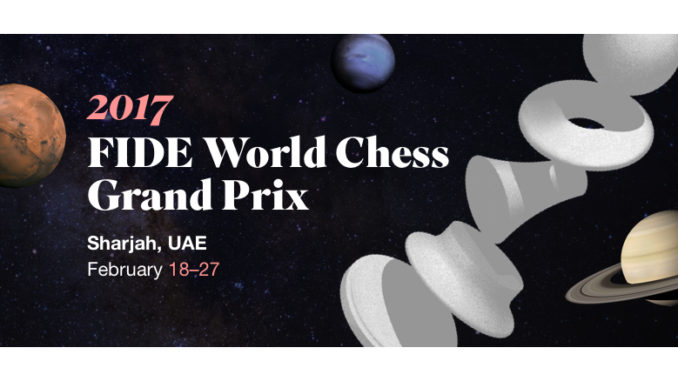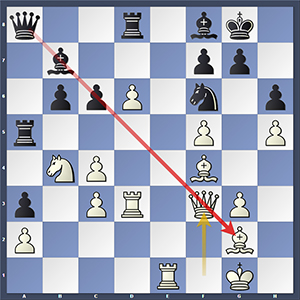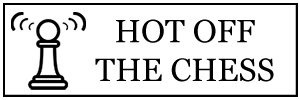
The first FIDE Grand Prix of 2017 got underway in Sharjah, United Arab Emirates, on Saturday 18th February. Competing in the tournament are: Maxime Vachier-Lagrave (FRA 2796), Levon Aronian (ARM 2785), Hikaru Nakamura (USA 2785), Shakhriyar Mamedyarov (AZE 2766), Liren Ding (CHN 2760), Pavel Eljanov (UKR 2759), Michael Adams (ENG 2751), Ian Nepomniachtchi (RUS 2749), Alexander Grischuk (RUS 2742), Chao Li (CHN 2720), Evgeny Tomashevsky (RUS 2711), Dmitry Jakovenko (RUS 2709), Francisco Vallejo Pons (ESP 2709), Richard Rapport (HUN 2692), Alexander Riazantsev (RUS 2671), Saleh Salem (UAE 2656), Yifan Hou (CHN 2651), Jon Ludvig Hammer (NOR 2628).
It is a nine-round Swiss tournament, with the following classical time control: 100-minutes for 40 moves, then 50-minutes for the next 20 moves. After move 60, the players get 15-minutes added to their clock for the rest of the game. There are increments of 30-seconds from move one.
Adams, Rapport, Vachier-Lagrave Waste No Time
Round one saw Michael Adams, Richard Rapport and Maxime Vachier-Lagrave, striking early, each taking a point in order to set out their stalls at the top of the standings board.
Vachier-Lagrave vs Li, was a Petrov’s Defence which didn’t really do what it says on the tin on this occasion. It left theory upon Black’s 12…Bxe5 and from here, White set up on the Kingside and Black looked towards the Queenside. 21.Bc2 was a little slow by White, allowing Black to pass his b-pawn with 21…b4 and 22…b3 and this pawn would actually reach the b2-square. White seemed to have everything in hand, however and was himself going straight for the jugular on the Kingside, playing for mate.
This led to the exchange of Queens on move 28 with approximate equality. Unfortunately for Li, the endgame didn’t really work out for him, his b-pawn was exchanged for Vachier-Lagrave’s e-pawn, which left Black with very little, and from here White became the much more active of the two. His rook and light-squared bishop were especially influential upon the position and worked together on the Queenside to decide the day.
Ding vs Rapport was a tense Queen’s Indian, in which you just knew that something could go wrong at any time should one of the players have a lapse in concentration. The board remained very full, with lots of confrontation in the centre. White had slightly more space, but Black was by no means passive. Saying that, White held the best of things until his 33.Qf3(? see diagram — Qf2 would have been better).

At first glance, this looks perfectly fine, as yet there are no threats along the long diagonal, and Ding obviously figured that the c-pawn is pinned and inadequately defended and therefore Black has to do something about it. Rapport opted for 33…Rxf5, which is the optimum way to proceed, anything else being very good for White. Ding’s advantage has ebbed away, here but he is still ok as long as he is accurate. Best is probably: 34.g4 (in itself a natural move due to h5 being en prise and the placement of the Black rook) c5 35.Nd5 Bxd5 36.cxd5 Rxf4 37.Qxf4 Bxd6 is about equal upon 38.Qf5.
However, Ding got his calculations wrong and plumped instead for the faulty 34.Nxc6(??). From here, 34…Rxd6(!!) was a very rude awakening.
Here, White is obviously at risk of losing the knight on c6, which explains Black’s 35.Rxd6, which looks absolutely obligatory. There followed 35…Bxd6 36.Ne7+ Bxe7 37.Qxb7 and here comes the finesse of this position, 37…Bc5+(!). This is a great zwisenchug, which puts the King on f1 due to Kh1/Kh2 leading to mate. This is very significant as the rest of the game shows. There followed: 38.Kf1 Qxb7 39.Bxb7 Nxh5 and now we see that Black will pick up a pawn with …Nxf4 and …Rxf4. After this Rapport will have a huge majority on the Kingside and White is technically lost. The game concluded with 40.Re8+ Bf8 41.Kg2 Nxf4+ 42.gxf4 Rxf4 43.Bd5 and White resigned without waiting for Black to begin launching his g and h pawns.
The other winner of the round was Michael Adams, who stamped some authority on his game with Saleh Salem. Adams got the better of his English Opening quite early on, letting a pawn go for immense activity. Black was on the back foot from here and never looked like getting an equal presence in the game. Adams’ pressure towards Salem’s King led to him picking up the Black Queen for a rook and bishop, which might have been valid return in some instances, but in this case White was just winning. The Englishman had no trouble converting — a very nice, dominant game.
The other games were drawn, but Jon Ludvig Hammer had a bit of an escape against Alexander Grischuk. In another English Opening, the Russian built up a very nice position, with a lot of pressure on the Queenside and ended up netting a pawn. Unfortunately for Grischuk, time was not on his side and one or two ineffective moves in a time scramble allowed Hammer off the hook. In particular, White’s hesitancy to play b4-b5, especially on move 30, probably cost him. His 30.Qc6 was not really good enough and the point was split not long after. The Norwegian said on his Twitter after the game, that he would cross “trick Grischuk in a time scramble” off of his bucket list.
This leaves a three-way tie at the top of the table, between Vachier-Lagrave, Adams and Rapport at this extremely early stage.
Full results: Vachier-Lagrave 1-0 Li; Tomashevsky ½-½ Aronian; Nakamura ½-½ Jakovenko; Vallejo Pons ½-½ Mamedyarov; Ding 0-1 Rapport; Riazantsev ½-½ Eljanov; Adams 1-0 Salem; Hou ½-½ Nepomniachtchi; Grischuk ½-½ Hammer.
World Chess Championship 2018
With the start of this tournament, the 2018 World Chess Championship cycle also kicked off. Twenty-four players are taking part in the Grand Prix series, each taking part in three of the four tournaments. These are: Sharjah (Feb 17-28), Moscow (May 11-22), Geneva (July 5-16), Palma de Mallorca (Nov 15-26).
Thus, each tournament will have eighteen players. The top two finishers at the end of the series will qualify for the 2018 World Chess Championship Candidates tournament.
Those not in Sharjah, but beginning their campaigns later, are: Anish Giri (NED 2769), Harikrishna Pentala (IND 2758), Peter Svidler (RUS 2748), Ernesto Inarkiev (RUS 2723), Boris Gelfand (ISR 2721) and Teymour Radjabov (AZE 2710).

